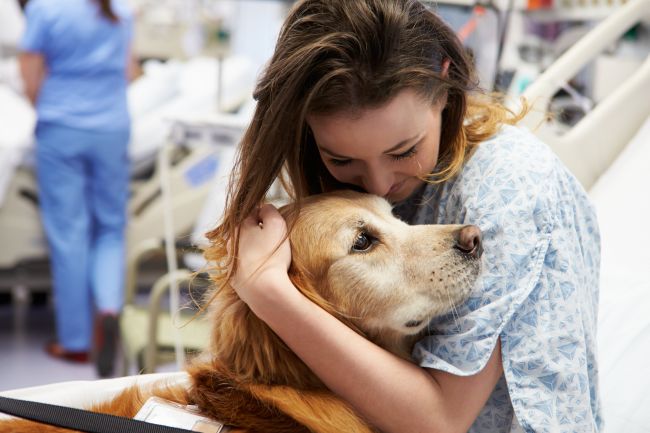
Animals tend to bring a positive presence wherever they go. Therapists have found animals to greatly improve their patients’ progress whether in emotional, mental or physical therapy. Both doctors and psychiatrists observe that patients become more relaxed, trusting, and are able to communicate better, with the help of an animal. Institutions like the Bethlem Hospital in 19th century England routinely brought animals into the ward, which greatly aided in patient recovery and morale. Even Sigmund Freud, Florence Nightingale, and the United States Military have all promoted canine interaction for psychiatric patients.
Currently, pet therapy animals and special needs assistance dogs are welcomed in private homes, mental hospitals, nursing homes, schools, prisons, universities and group homes. Pet therapy can consist of an animal simply being present in the hospital or stressful situation; or when a pet joins therapy sessions while a patient communicates with the therapist. Organized systems of pet integration in therapy follow these basic steps for Animal Assisted Therapy (ATT) technique:
Step 1: The therapist meets with the patient to assess the level of need/desire of interaction with the animal. (For example, a patient suffering from a debilitating fear of dogs might then be able to express their adamant desire to avoid the presence of a dog.)
Step 2: The pet is introduced to the sessions. The patient engages with (grooms, talks to, connects with) the pet. The patient is told to go get them water and food (thereby practicing motor skills and using the pet’s need as motivation), and the patient practices giving commands like “sit” and “stay” to the pet.
Step 3: The sessions continue, until the patient is able to consistently interact with humans as well as they do with the therapy animal.
Patients Who Would Benefit From Pet Therapy
- Cancer patients
- People in long-term care facilities
- People with chronic pain or terminal illnesses
- Veterans with PTSD (post-traumatic stress disorder)
- Mentally-ill patients battling depression, schizophrenia, etc.
- Patients with social disorders or speech impediments
- Patients with social anxiety or fear of travel, large crowds, or leaving their homes, etc.
- People with high blood pressure and stress levels
- Autistic patients
- Children with learning disabilities, hyperactivity, ADD, or ADHD
- Emotionally or physically abused patients
- Elderly people with dissociative disorders
Results of Pet Therapy
Working in recovery with animals has been scientifically proven to increase emotional, mental and physical health for the patients. Whether a child struggling with reading in school, or a depressed and isolated elderly man, animals bring a soothing presence that builds confidence, a sense of importance and worth in discouraged patients. Below are some of the benefits that result from pet therapy:
- Releases endorphins/hormones like oxytocin and dopamine (bonding/positing feelings)
- Petting animals instigates an auto-relaxation response in the person petting
- Decreases feelings of loneliness and isolation
- Offers comfort and a stable presence.
- Encourages patients to open up, express their feelings
- Makes the patient feel safe and unrushed
- Deceases feelings of anxiety and vulnerability
- Improves social skills
- Improves communication and boldness
- Aids speech impediments
- Lowers depression
- Helps children direct and maintain their focus
- Helps client increase self-esteem
- Provides motivation to work harder and recovery faster

